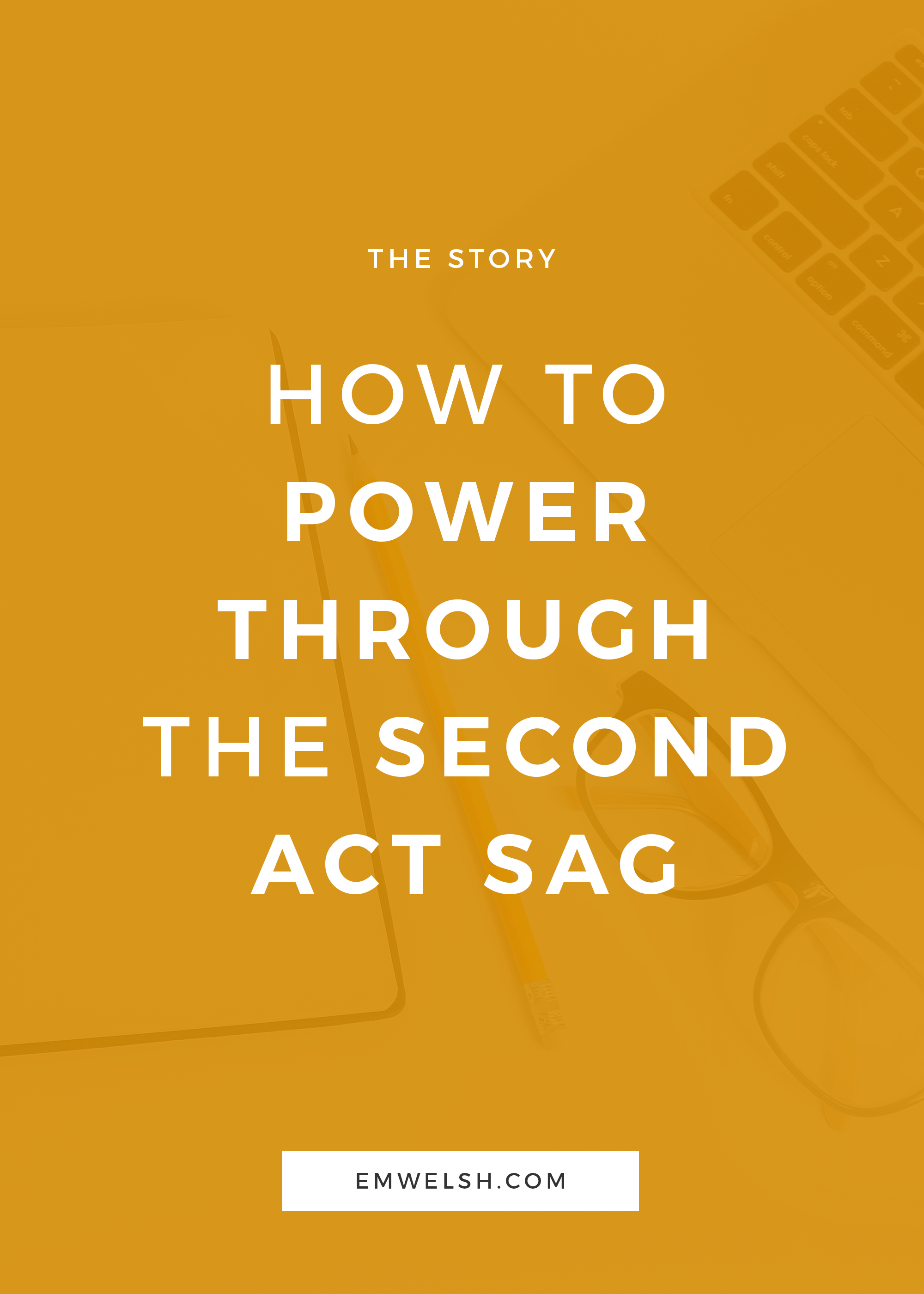How to Power Through the Second Act Sag
/Whether you follow a three-act structure or write a more "structureless" story like literary fiction, you will eventually encounter the dreaded second act. Often called the "second act sag," this part of the story has been know to trip many writers up, and it's been given that name for a reason.
By comparison, writing act one can be so incredibly fun. While writing the first few pages or lines can always seem difficult, even for people who neglect outlines and write by the seat of their pants, writing the first act is surprisingly easy. We know we have to introduce characters, settings, conflicts and everything else, and that's a really easy thing to get behind because we've seen it done so many times. Additionally, it's just plain fun to start a new story.
But then we get to the act one break, when the hero has to address their conflict, then what? We know we have to get to the end of the story, but how do we do that without just cutting to the end? What will our character do during all that time? Will they sit around and do a lot of thinking? Will they wander the earth and run into people? Will a massive storm hit their town and rush them into the final act?
As you might have guessed, these have all been my own solutions to second acts, and they have all felt as random and thoughtless as they sound.
Approaching the second act can feel like staring in an abyss of darkness with no end in sight. In a screenplay, the second act is the longest one, nearly 60 pages long, double the length of act one. In other mediums, while there's no rule to how long it should be, it generally takes up a half the story.
While we may come into our story knowing perfectly well a few conflicts, often as we approach the middle a lot of passion teeters out and we lose steam to keep going. This isn't helped by the fact that often as writers stuck in the second act sag, unsure of where our story is even going in the first place.
Unfortunately, a rough second act makes it nearly impossible to write a decent third act because you will have set up a weak foundation for your story. While the beginning is important to get your story started off on the right foot and hook your audience in, if you start to go against what your beginning promised, people will be disappointed and often leave your story unfinished.
For example, let's say you promise an adventure novel but halfway through your characters just spent a lot of time talking and not doing much. More than likely, you'll reader will quit the story because even if the first act was amazing, the second act must maintain some hint of that promise. Usually when your second act starts to falter and you lose track of what to fill the blank space on the page with, this will happen.
Even if you are writing a structureless novel, if you hardly do anything in the middle without some sort of purpose to it or end goal, readers, viewers, players, and so forth can tell. For that reason, action doesn't mean your second act is fixed or without problems, which is often why people writing literary fiction have so much trouble with the second act. Say your story starts the first act out slow and promises a picaresque story. If you start going against that promise in the second act by having a fast-paced love story, you'll also face similar troubles.
“When readers say an ending was satisfying, or moved them, they are really saying the writer did a good job with the journey to get there.”
While I've talked about ways writing the second act is so difficult, that really does little to actually fix the problem of a sagging second act. I remember in university often getting notes about how my second act needed help or how the middle of my novel just felt like it came from a different book.
Every time these notes were right, but they didn't teach me how to fix the problem. And while over time I've learned it really comes from experience and practice (I know, a boring, typical answer), there are certain tricks to helping you find elements of your story to explore in the second act.
However, before you even begin to learn these tricks, it's essential that you understand what usually happens in a second act, even if your storytelling persona is completely against structure. After all, you really must learn the rules before you break them.
Luckily, my friend Kristen over at Well-Storied does a great job going into detail about what the second act is all about, so instead of trying to reiterate the same thing myself, I am just going to point you to her so I can spend more time telling you some other ways to fill your act two. After you feel like you've got act two down, then it's time to read some strategies to tackling it!
Explore Side Characters
The most fun and easy way to get through your second act is to give some time to the side characters. Not every part of your story needs to be about your protagonist, and the second act has ample room to give to other characters. If you watch a lot of movies, you'll notice they do this all the time without you even noticing, even in character-study pieces. Whether it's a scene where two side characters discuss worries about your main character, or a dilemma that is making things harder for your side character to help your protagonist, the sky is the limit.
Exploring a side character doesn't even mean you need to leave your protagonist behind. Draw them into a conversation with someone, discuss a philosophy you believe is essential to your story, or just use them as a way to show a different way your main character interacts with others. My only caution is to not give them too much of the spotlight, otherwise you may have to do a lot of rewriting later in the first act that might further complicate things.
Create More Problems
One of the reasons your second act may be struggling is because you are going way too easy on your main character. If the path towards act three seems like a straight shot forward, then you need to add some extra conflicts to your story. Even in a more passive story, you want to create as many situations as possible for your characters to address the main conflict in one way or another.
If you are having trouble thinking of these conflicts (which is usually the case, hence why you are stuck in act two limbo), think about what your character wants more than anything, then make a list of ten different ways you can take that from them and make it impossible for them to get it back. Keep coming up with more problems, even if they're outlandish, until you find some that fit your narrative and create tension for the final act. If this still doesn't feel like enough, try creating more problems for your side characters or for your world too! Just don't overdo it so it seems like everything is coincidental or random.
Develop the Internal
If you are writing an external story, or even if you aren't, looking to the internal dilemmas can help push you through the second act. Why? Because when you deeply address what your character is internally dealing with, you can think of new problems that will both build and break that about them.
Oftentimes this is where characters in stories will have philosophical or deep discussions that get to theme of your story or see something seemingly random that connects to their own personal struggle and provides an answer. The internal is a great place to talk about themes, big pictures and make connections without being overly cheesy. When you're in act two, these conversations seem more "matter-of-fact" than they might in act three, where they often feel more forced or like a "life lesson." Use the second act to explore these bigger issues in dialogue or in images and see how they add to the conflicts of your story.
Divide and Conquer
If you are still stuck in your second act despite all the help above, then there is no better solution than to divide and conquer, incorporating the tips I've mentioned. There are a few ways to do this, one of which is just dividing your story around the midpoint and treating act two as two separate acts. However, you can also look to the classic five-act structure for guidance as well.
I'd like to think there's a reason Aristotle divided his plot structure into five acts, perhaps because he knew any writer staring down the enormous second act would have trouble getting through it and knew to break that up. And while the structure may seemed outdated to you, looking at how he broke up a story might be the fresh perspective you need.
A final approach, especially for screenwriting, is the Eight-Sequence method created by the Script lab. As you might have guessed, this splits the story into eight pieces, dividing act two into four segments instead of two or three. I have found for writing screenplays this works incredibly well and is a preferred approach of mine, however you can also easily incorporate this format into other storytelling forms without a problem, something I detail in my post explaining the Eight-Sequence method.
No matter how your story turns out, if you can push through the second act, take heart in knowing that anything you struggled with during the writing process can be fixed in the editing. A break from your work may awaken you to new solutions or ways to thicken your second act to prevent rushing your story to the end. After all, the second act is your story. So take the time to make sure it feels right.
Dealing with something bigger than the second act? Read my post on how to get out of a storytelling slump!


